|
 Tissiman's the tailors is the oldest business in Bishop's Stortford. It is in fact, according to Family Business Magazine, the 26th oldest family business in the world and the third oldest family business in the UK. Legend has it that the firm was founded in 1601 by William Tissiman, a man of Swedish stock whose name in Swedish means 'fabric man'. The establishment date may be correct and there might well be a distant link with Scandinavia, but William Tissiman did not found the original tailoring business in 1601. Tissiman's the tailors is the oldest business in Bishop's Stortford. It is in fact, according to Family Business Magazine, the 26th oldest family business in the world and the third oldest family business in the UK. Legend has it that the firm was founded in 1601 by William Tissiman, a man of Swedish stock whose name in Swedish means 'fabric man'. The establishment date may be correct and there might well be a distant link with Scandinavia, but William Tissiman did not found the original tailoring business in 1601.
The last member of the Tissiman family to own this shop was Henry Arthur Jack Tissiman, better known as Jack Tissiman. He was born in 1912 to Arthur Tissiman and Mabel Copley, who married in Bishop's Stortford in 1907. But Arthur was not of the Tissiman bloodline. He was the stepson of William Henry Simms Tissiman (1862–1933), born at Gravesend in Kent, who married Eliza Hawkes Goldstone in 1883. Arthur had a brother, Frederick, both the product of Eliza's previous marriage to Frederick Goldstone (1852–1883) of Chelmsford, a painter & plumber.
William Henry Simms Tissiman was the son of Thomas Tissiman (1827–1872), born in Pickering, Yorkshire, and his mother was Elizabeth Simms. They married in 1853 in Derby, but by 1859 were living in Gravesend, Kent. There, Thomas became a customs officer and died at Gravesend in 1872.
Thomas's father was the son of John Tissiman (1806/07–1870), a Spirit merchant born in Scarborough, Yorkshire, who married Ann Burniston of Pickering, Yorkshire. It was at this time that the family surname changed to Tissiman – John being the son of *John Tesseyman (1778–1822) born in Scarborough, who married Mary Posgate in 1800. John Tesseyman's father, also John Tesseyman (1748/49–1808), married Elizabeth Atkinson in Seamer, Yorkshire, 1772.
*There are many variations of the name Tesseyman, which is most commonly found in Yorkshire and also in Scandinavia. It may date back to the Danish occupation of this country in the 9th and 10th century (See Guide 7 – Danelaw). A descendant of William Henry Simms Tissiman, who has contacted me, believes the name may previously have been Tesman which is fairly common in Germany and Scandinavia.
In 1883 William Henry Simms Tissiman, aged 21, was a tailor living in London, and in 1891 is listed as tailor in Woodford, Essex. After marrying Eliza Goldstone and taking on her two sons, they produced two daughters of their own. In 1893 William and his family arrived in Stansted to take over William Brindley's tailoring and woolen drapers shop, and in 1901 he was a merchant tailor in Silver Street, Stansted. Of his adopted sons, Frederick was a tailor and cutter and Arthur was an apprentice tailor.
The earliest evidence of Tissiman's in Bishop's Stortford is found in a ledger book dated 1879–1913 [HALS: D/ETs B31]. In it, a loose bill dated 30 April 1906, with a Tissiman & Sons printed heading, includes the words 'Est. upwards of 150 years'. Before becoming Tissiman & Sons in the early 1900s the tailor's shop at 10 High Street had been Slater & Sons since at least the late 1700s. This is confirmed by a ledger book dated 1788 [HALS: D/ETs B22] that bears John Slater's name, and by various trade directories from 1811–1902.
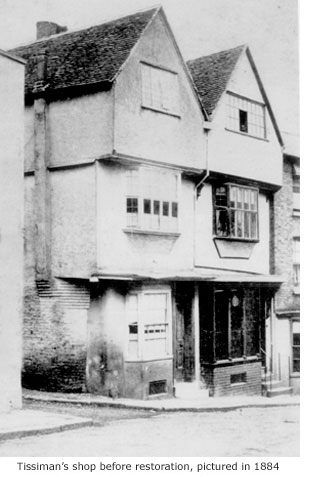 With no record of tailoring in the Tissiman family until William in the 1880s, there is ambiguity in the statement 'established upwards of 150 years'. The claim was possibly based on the length of time the business was previously owned by Slater's, if indeed Slater's took over the firm in the mid 1700s. Of course, the Slater family may have founded the business in 1601 and this cannot be disproved, but the earliest mention of the name in local records is 1642 – a Mr Slater holding a tenement in South Street. With no record of tailoring in the Tissiman family until William in the 1880s, there is ambiguity in the statement 'established upwards of 150 years'. The claim was possibly based on the length of time the business was previously owned by Slater's, if indeed Slater's took over the firm in the mid 1700s. Of course, the Slater family may have founded the business in 1601 and this cannot be disproved, but the earliest mention of the name in local records is 1642 – a Mr Slater holding a tenement in South Street.
At the present time the actual founder of the business and the date of its establishment will have to be left to further research. It should be noted however that if the establishment date was 1601, then all subsequent owners of the business have been legally entitled to use this date because it has remained a tailors throughout.
Slater's made their mark in the town by the making of liveries for *family estate retainers i.e. fitting out entire staffs with tailor-made uniforms. The attention to detail even included custom-made buttons with individual patterns for different jobs. In the 19th century Slater's also supplied uniforms for the nonconformist school (now the college), the Grammar school, the local Gas company (four employees), and army officers. One of Slater's best clients appears to have been the 1st Herts Light Horse Volunteers. An order book dated July 1900 lists the following items for kitting out more than 30 men. For each: Tunic 19s; Shoulder pads 1s; Serfe frock 11s 10d; Cap 2s 6d; Great coat 16s 6d. Miscellaneous items included buttons, cap badges, water bottles, belts, waist hooks and boots. The grand total came to £113. 8s. and the bill was paid by cheque.
*The supply of liveries to estate owners continued into the 1900s, Tissiman's at one time supplying livery for Sandringham House and Windsor Castle.
A little known fact is that Slater's was also once the local undertakers. Having supplied the highest standard of service and tailoring to the local gentry, upper classes and even the common man in life, they offered the same in death. Funeral books from the 19th and early 20th century record the passing of virtually every individual of local note that appears in this history, listing under each name the funeral expense incurred. Included are such items as the coffin, horse drawn hearse and coaches, church fee, undertaker's fee, and clothing bought by the bereaved and those attending the funeral. It was also customary to give a pair of black gloves to the vicar and any doctor attending each funeral. In the 19th century the average cost of dying for the well off was £45, although between 1700 and 1850 many accounts were apparently settled by a barter system.
John Slater died in 1847. To his wife Martha he left the freehold property of No 10 High Street and all his possessions including 'all the wines liquors fuel and other household store and provisions for her absolute use'; and to her and their two sons Thomas and John, and their heirs, he left the tailoring business. His heirs continued with the business until the early 1900s when they sold out to William Henry Simms Tissiman.
After William's death in 1933 the business passed to his adopted sons Arthur and Frederick Tissiman, and finally to Arthur's son, Jack, who died in 1970. Golding of Newmarket then acquired the business. They continued to trade under the familiar name of Tissiman but in 1996 sold out to current owner Tony Arnold, a former employee of Jack Tissiman.
Shortly before the death of Jack Tissiman's widow, Dorothy Mabel [Gardner] (1913–1972), order books, ledgers, and funeral books of the business dating from the late 18th century were deposited in the Hertfordshire Record Office (now HALS). Such is their importance that in the past, the London School of Economics have used these old ledgers to build up a picture of the country's economic history.
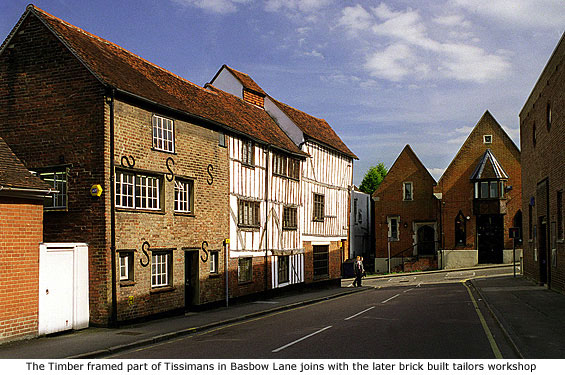
The tailoring business is housed in two adjoining buildings, numbers 8 and 10 Street High Street, but began in Number 10. Built around *1500 it is the town's earliest known timber-frame building, the first floor originally being jettied to the west and south above the pavement but subsequently cut back. The bow windows are thought to be early 19th century. Restoration work on these premises had been on-going since about 1920, but when Jack Tissiman took possession of the adjacent No 8 to enlarge his shop in 1967, he embarked on major restoration and refurbishment of both buildings. This led to the discovery that part of the site of No 10 dates back to the 14th century and, say experts, possibly started life as a farmhouse. The building was heightened to three storeys in the late 1600s.
*Hertfordshire Houses: Selective Inventory
Number 8 is a timber-framed half-Wealdon house, but its 16th century construction is part of an even older building dating back to 1132. Possibly having a flat roof when built, it was heightened to two storeys with attics in the 17th century, then heightened again in the late 19th century and re-fronted with brick. A photograph taken in the 1800s shows small bay windows either side of a central doorway, and a very low-pitched roof.
Like No 10, this was also probably a residential property before becoming a shop. In the 1920s the premises served as an employment agency for domestic servants, run by the Misses Bawtrees', then later became the 'Old House Café'. The 1967 restoration work involved the removal of No 8's Georgian brick facade to reveal the magnificent timber-frame structure beneath. The sand and cement render of No 10 was finally removed in 1976.
These buildings have stood through over 500 years of the town's history, but in 1884 both were severely shaken by the Great Earthquake of Essex. Ground tremors were so strongly felt at Windhill and High Street that staff of this tailor's shop reportedly fled in panic. Panic of another kind was no doubt experienced by past owner Jack Tissiman who, while working in his tailor's workshop late at night, often reported seeing the familiar ghost of the Grey Lady (See Guide 6 – Ghosts of Bishop's Stortford).
*The earthquake referred to took place on April 22nd, 1884, and its most disasterous effects were felt in and around Colchester. Fortunately, and almost miraculously, there was no loss of life. but considerable damage was done to buildings in various parts of Essex. In Colchester alone the aggregate damage was estimated at £50,000.
The following report appeared in the Herts & Essex Observer, April 1884:
The earthquake was distinctly felt in the town and neighbourhood. Mr Flinn, who was ill in bed, felt undulation and noted the occurence in his diary as having taken place at 9.21 a.m. Others were startled by being mysteriously shaken. At Messrs. Slater & Sons' tailoring establishment [High Street] the employees rushed downstairs thinking the workroom at the top of the old-fashioned house was falling outwards. The vibration was also felt at the London and County Bank [Market Square], the Grange [Rye Street], Wharf House [Causeway], the steam mill in South Street, the Workhouse [Haymeads] and in several private houses bells were rung and articles of furniture moved, but no damage was done.
|
|
Bishop's Stortford Art Society
Bishop’s Stortford’s immense character and many fine old buildings have always held great appeal for artists. In view of this, Mr A G Tidmarsh of Bishop’s Stortford College decided to provide a local focus for those interested in sketching and painting, and in 1931 formed the informal Folio Club. The name came from the fact that the club’s folio of artwork was passed around its members, who then wrote their comments and criticisms on the back of each drawing. The club spawned many good artists, one notable member being a local man named John Blake, whose sketches and watercolours of town scenes now hang on the walls of the Royal British Legion in Windhill (See Guide 4).
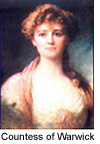 In November 1934 a major art exhibition was held at the Corn Exchange to raise funds for Bishop’s Stortford Hospital. The guest of honour was one Professor A E Richardson, and included many art treasures and paintings loaned by local people as well as works by members of the Folio Club. So successful was the event that it encouraged Mr Tidmarsh and a fellow art enthusiast, Octavius Wright, to invite members of the public to form the Bishop’s Stortford Art Society. Their first exhibition was held on 21 November 1935 in St Michael's Parish Hall (pictured above), and comprised nearly three hundred items that included statuary, photographs, needlework, drawings and paintings. The event was opened and attended by the Countess of Warwick of Easton Lodge. In November 1934 a major art exhibition was held at the Corn Exchange to raise funds for Bishop’s Stortford Hospital. The guest of honour was one Professor A E Richardson, and included many art treasures and paintings loaned by local people as well as works by members of the Folio Club. So successful was the event that it encouraged Mr Tidmarsh and a fellow art enthusiast, Octavius Wright, to invite members of the public to form the Bishop’s Stortford Art Society. Their first exhibition was held on 21 November 1935 in St Michael's Parish Hall (pictured above), and comprised nearly three hundred items that included statuary, photographs, needlework, drawings and paintings. The event was opened and attended by the Countess of Warwick of Easton Lodge.
In the 1980s the society's former president for 28 years (1970–1998), Peter Walbourn (d.2002), was invited to paint a portrait of the Queen Mother. The Bishop's Stortford Art Society – currently with more than 80 members – continues to flourish and holds regular exhibitions at various venues in the town.
The Swan public house
Records also tell us that High Street was once home to the Swan public house: first mentioned 2 July 1578 when the owner, Colonel Thomas Jernegan and his wife, Elizabeth, granted, by indenture... 'the said messuage (then called The Swan) and the appurtenances unto the use of James Whitlowe and his heirs forever.'
It appears again 10 July 1582: by will.. the said James Whitlowe devised... unto Katherine his wife all his houses and lands... then unto Edward his son... or Lucy his daughter... the said messuage he bought of Mr Jernegan (except a little piece of the yard therein mentioned) and all other lands, grounds whatsoever... if both die without issue... to [be divided equally between] his wife's 5 brothers and sisters the said house he bought of Mr Jernegan called the Swan (except the said parcel of land).
The said 'parcel of land' appears to have been part of a shared yard used by properties in this particular part of High Street, which I take to be between Basbow Lane and King Street (now the site of the police station). In an indenture dated 20 July 1612, in which the sale of a tenement [possibly in Basbow Lane] by John Blancke included use of a little yard adjoining a messuage called The Swanne [sic], usage of the yard by the buyer [Thomas Barbour] of the tenement is qualified thus: 'and also free liberty... to and for Thomas Barbour... where he dwells to cart, carry and lay down wood and fewell [fuel] in the yard of the said messuage of the Swanne and to take away the same, and to fetch and carry water from the pump or well in the said yard according to a pair of indentures heretofore made between John Blancke and Robert Bowyere' [owner of the Swanne].
*Information about the Swan public house is thanks to Spencer Thomas
MORE PICTURES
|

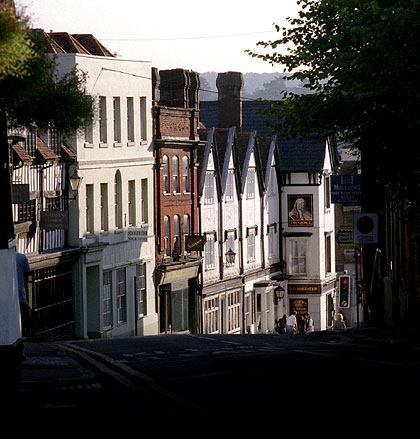


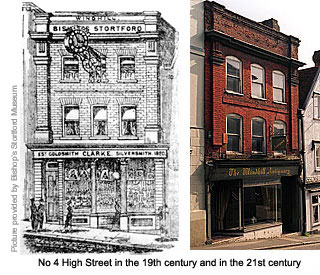 Returning to No 4 High Street, this three-storey red brick building was built c.1740 as a private residence. It became a shop in the early 19th century and in 1841 was occupied by a chemist and Glover. Ten years later Samuel Fiske an attorney at law with the court of common pleas was in residence, and in 1881 it was occupied by Henry J Clarke, jeweller. By 1891 Mr Clark had been replaced by a Mr Loveday, watchmaker.
Returning to No 4 High Street, this three-storey red brick building was built c.1740 as a private residence. It became a shop in the early 19th century and in 1841 was occupied by a chemist and Glover. Ten years later Samuel Fiske an attorney at law with the court of common pleas was in residence, and in 1881 it was occupied by Henry J Clarke, jeweller. By 1891 Mr Clark had been replaced by a Mr Loveday, watchmaker.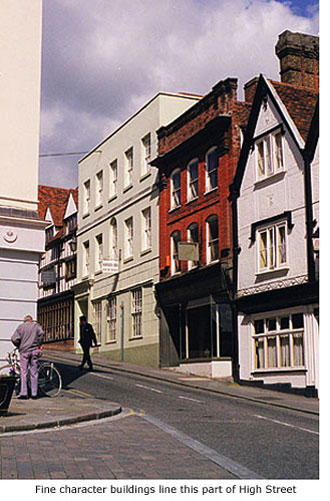 In 1914 he is listed as solicitor living at Stort Cottage, Warwick Road, and in 1915 established his own business in premises said to have been on the opposite side of the road to the current offices. The firm moved to No 6 in 1920.
In 1914 he is listed as solicitor living at Stort Cottage, Warwick Road, and in 1915 established his own business in premises said to have been on the opposite side of the road to the current offices. The firm moved to No 6 in 1920. Tissiman's the tailors is the oldest business in Bishop's Stortford. It is in fact, according to Family Business Magazine, the 26th oldest family business in the world and the third oldest family business in the UK. Legend has it that the firm was founded in 1601 by William Tissiman, a man of Swedish stock whose name in Swedish means 'fabric man'. The establishment date may be correct and there might well be a distant link with Scandinavia, but William Tissiman did not found the original tailoring business in 1601.
Tissiman's the tailors is the oldest business in Bishop's Stortford. It is in fact, according to Family Business Magazine, the 26th oldest family business in the world and the third oldest family business in the UK. Legend has it that the firm was founded in 1601 by William Tissiman, a man of Swedish stock whose name in Swedish means 'fabric man'. The establishment date may be correct and there might well be a distant link with Scandinavia, but William Tissiman did not found the original tailoring business in 1601. With no record of tailoring in the Tissiman family until William in the 1880s, there is ambiguity in the statement 'established upwards of 150 years'. The claim was possibly based on the length of time the business was previously owned by Slater's, if indeed Slater's took over the firm in the mid 1700s. Of course, the Slater family may have founded the business in 1601 and this cannot be disproved, but the earliest mention of the name in local records is 1642 – a Mr Slater holding a tenement in South Street.
With no record of tailoring in the Tissiman family until William in the 1880s, there is ambiguity in the statement 'established upwards of 150 years'. The claim was possibly based on the length of time the business was previously owned by Slater's, if indeed Slater's took over the firm in the mid 1700s. Of course, the Slater family may have founded the business in 1601 and this cannot be disproved, but the earliest mention of the name in local records is 1642 – a Mr Slater holding a tenement in South Street.
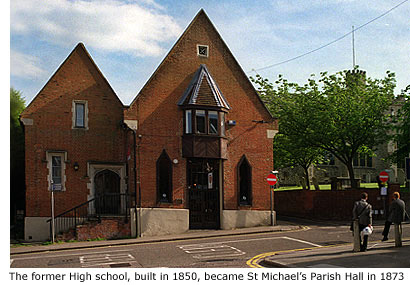 Opposite Tissimans, dominating the corner of High Street and Church Street, stands a large, 19th century red-bricked building with two prominent gables. This was once the town’s prestigious High school, purpose built in 1850 on the former site of Bishop’s Stortford’s Grammar school, renowned for its academic qualities for almost 300 years.
Opposite Tissimans, dominating the corner of High Street and Church Street, stands a large, 19th century red-bricked building with two prominent gables. This was once the town’s prestigious High school, purpose built in 1850 on the former site of Bishop’s Stortford’s Grammar school, renowned for its academic qualities for almost 300 years. In November 1934 a major art exhibition was held at the Corn Exchange to raise funds for Bishop’s Stortford Hospital. The guest of honour was one Professor A E Richardson, and included many art treasures and paintings loaned by local people as well as works by members of the Folio Club. So successful was the event that it encouraged Mr Tidmarsh and a fellow art enthusiast, Octavius Wright, to invite members of the public to form the Bishop’s Stortford Art Society. Their first exhibition was held on 21 November 1935 in St Michael's Parish Hall (pictured above), and comprised nearly three hundred items that included statuary, photographs, needlework, drawings and paintings. The event was opened and attended by the Countess of Warwick of Easton Lodge.
In November 1934 a major art exhibition was held at the Corn Exchange to raise funds for Bishop’s Stortford Hospital. The guest of honour was one Professor A E Richardson, and included many art treasures and paintings loaned by local people as well as works by members of the Folio Club. So successful was the event that it encouraged Mr Tidmarsh and a fellow art enthusiast, Octavius Wright, to invite members of the public to form the Bishop’s Stortford Art Society. Their first exhibition was held on 21 November 1935 in St Michael's Parish Hall (pictured above), and comprised nearly three hundred items that included statuary, photographs, needlework, drawings and paintings. The event was opened and attended by the Countess of Warwick of Easton Lodge.